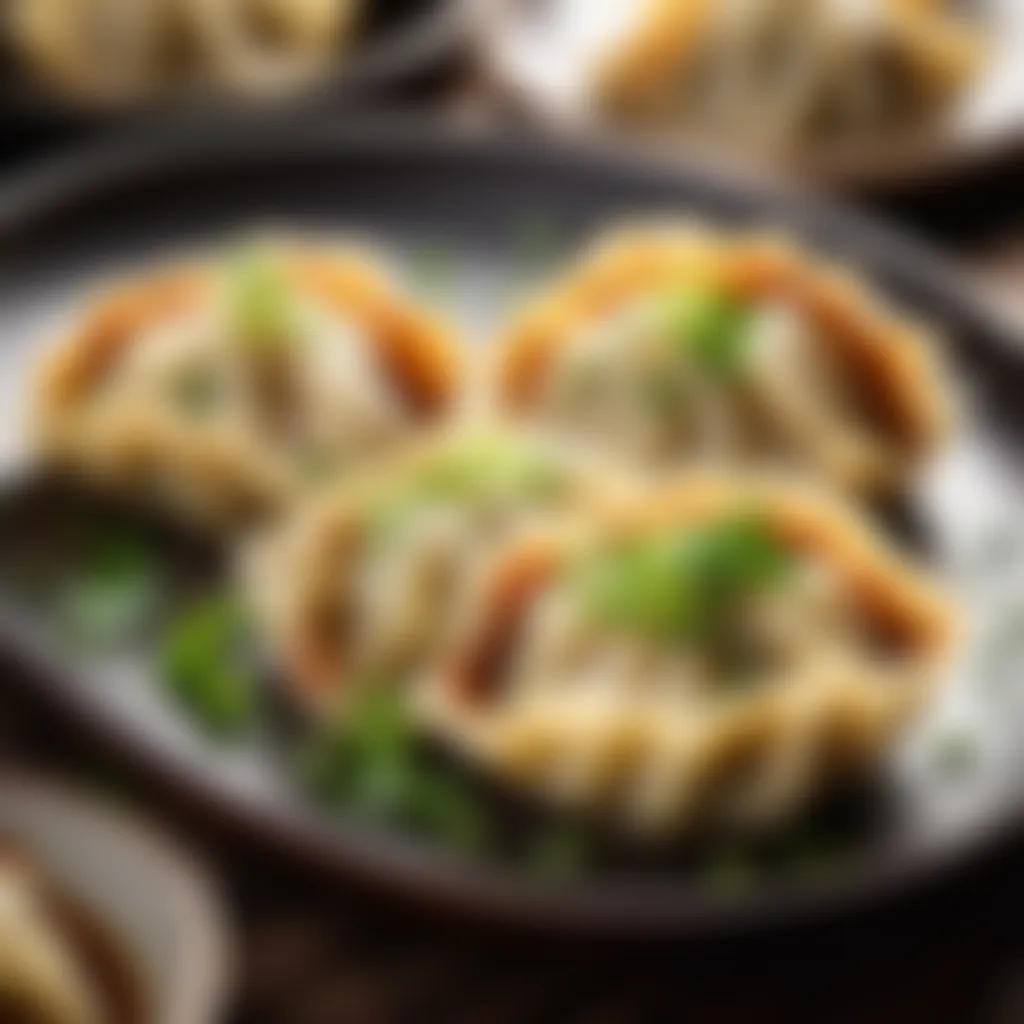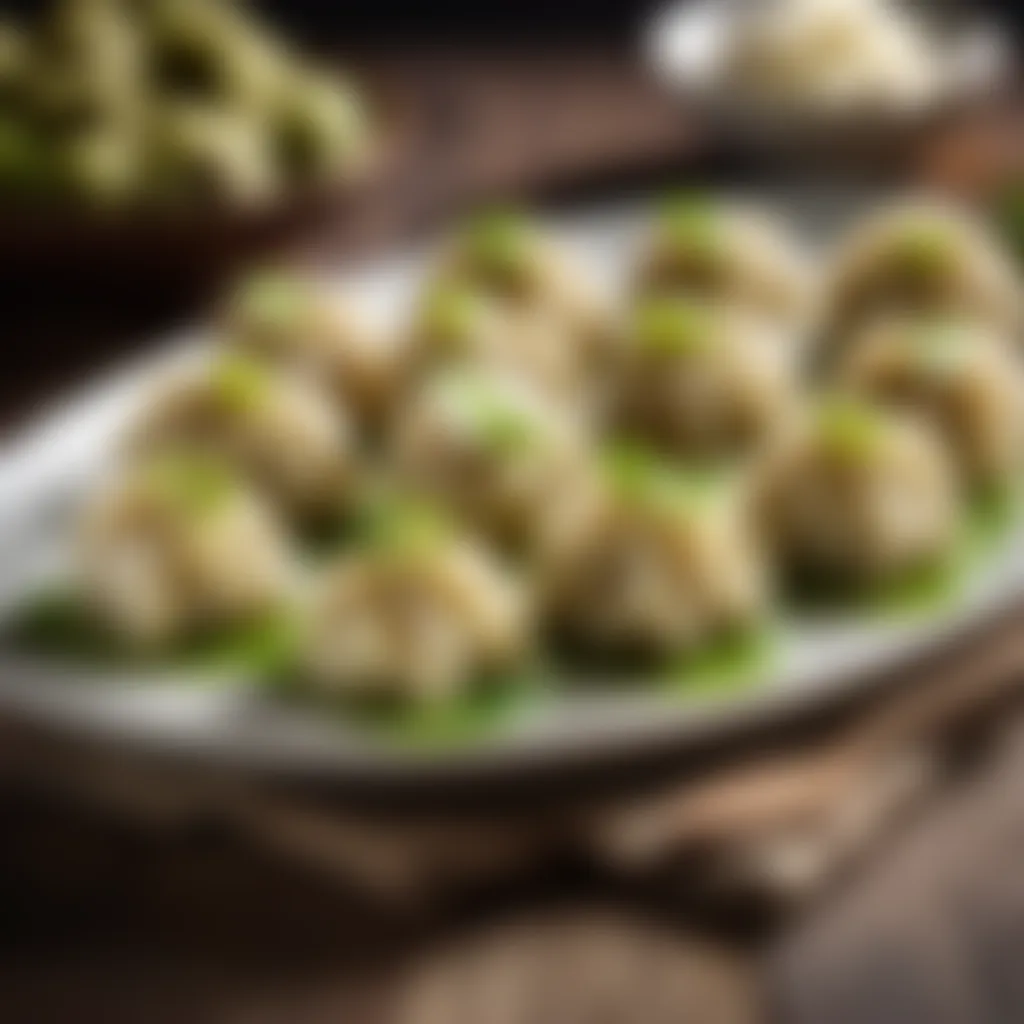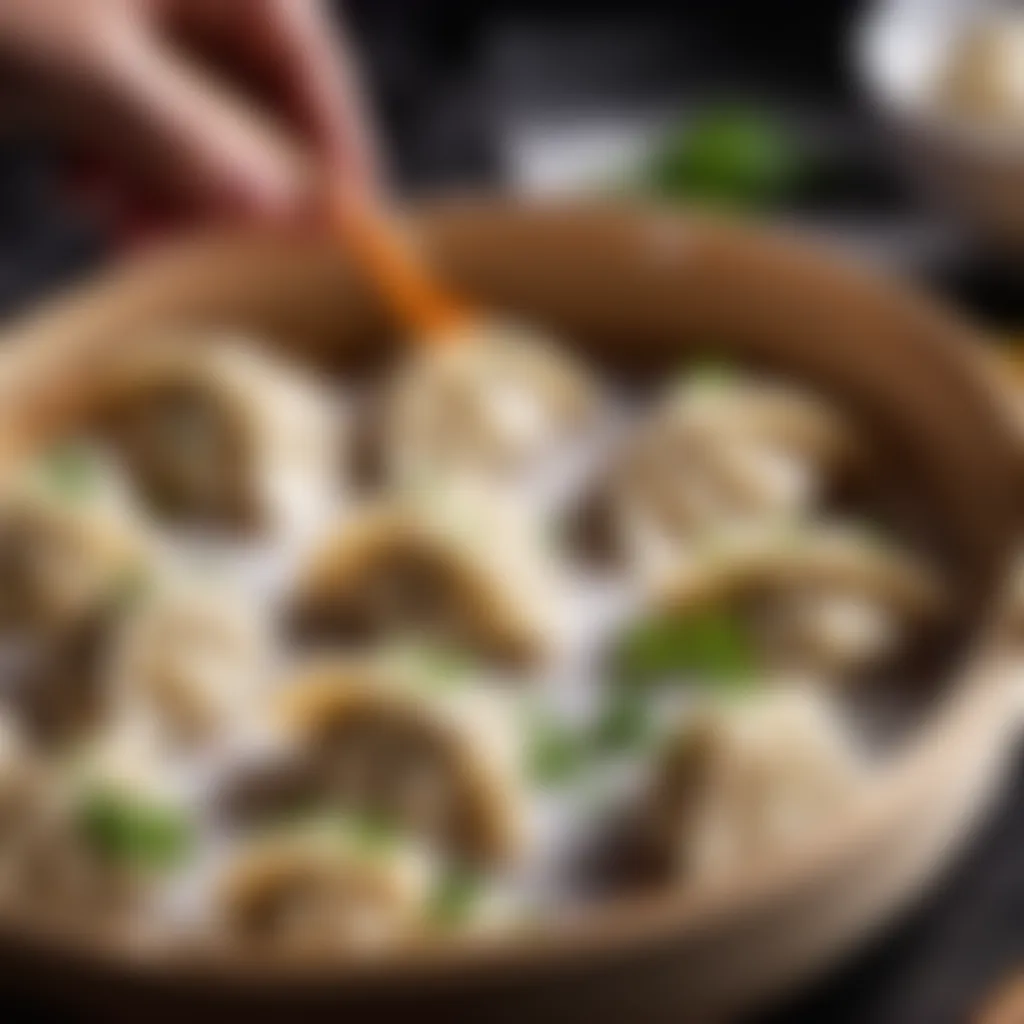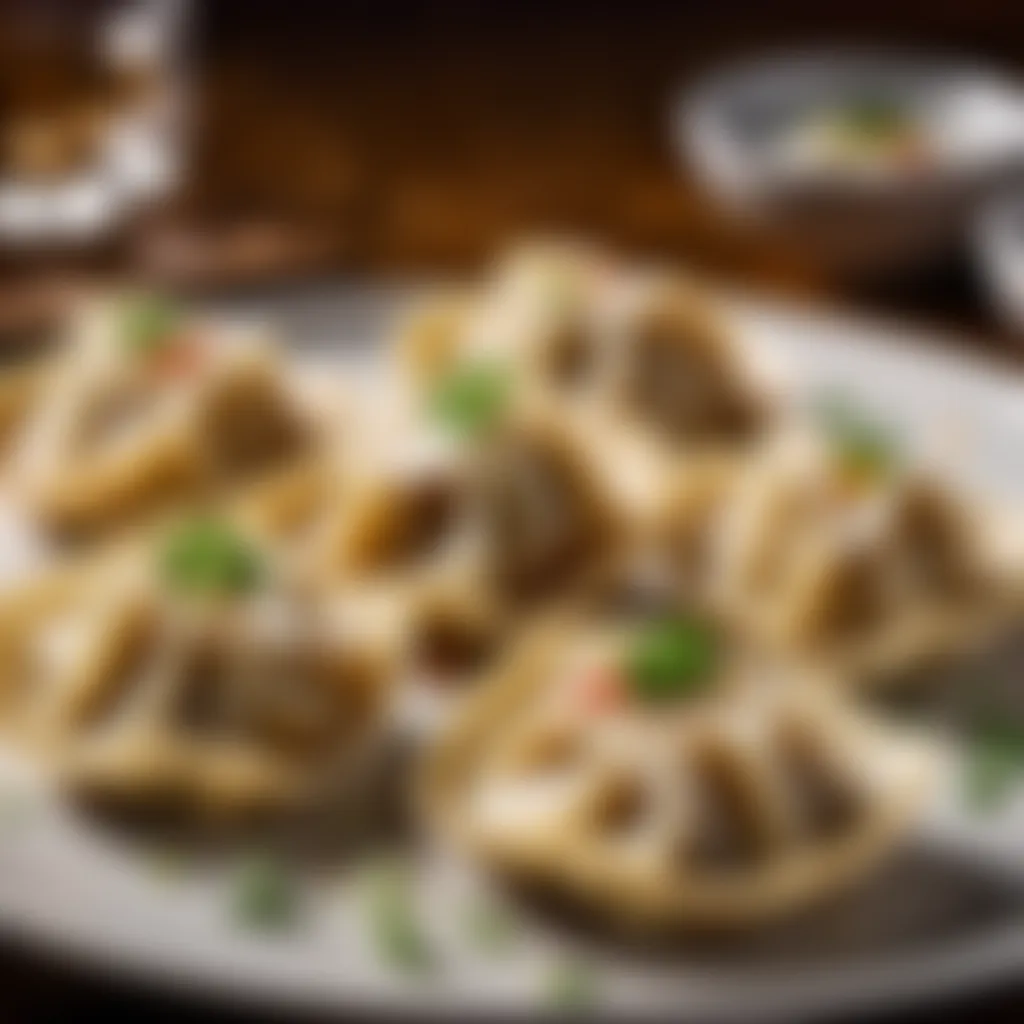Delicious Dumplings Recipe Inspired by New Zealand


Intro
Dumplings have long been a beloved staple in kitchens around the world, serving as a versatile canvas for various styles and flavors. The approach to crafting these delightful parcels varies widely, influenced by regional cultures, local produce, and time-honored techniques. In New Zealand, the fusion of indigenous ingredients with contemporary culinary innovations offers an exciting spin on dumpling-making traditions.
This article is your guide to creating authentic dumplings inspired by New Zealand's rich culinary landscape. We will dive into the essential ingredients, precise preparation steps, and the technical know-how required to perfect this dish. Aside from putting together a delicious meal, you’ll also appreciate the cultural significance behind each ingredient, which elevates the dumplings from mere food to an artistic expression of New Zealand's vibrant flavors.
To kick things off, let’s look at what you need to get those dumplings rolling.
Prelims to Dumplings
Dumplings hold a special place in the hearts and stomachs of many culinary enthusiasts. They're not just a type of food; they embody a rich cultural history and a nurturing connection to communities. In this article, we will dive deep into the world of dumplings, particularly through the lens of New Zealand’s unique flavor palette. Not only will we explore the various elements behind making authentic dumplings, but also the underlying story that gives them meaning.
The simple act of crafting dumplings presents numerous benefits. It fosters creativity, allows you to experiment with flavors, and most importantly, encourages family togetherness. In a world that often rushes past, dumpling-making can be a comforting ritual. It is an activity that can be enjoyed by housewives looking to whip up something special or families gathering for a meaningful meal.
Historical Context of Dumplings
Dumplings have a long and intricate history, tracing back to various culinary traditions around the globe. While the exact origins are hard to pin down, many historians agree they likely stem from a basic need to create nourishing meals using readily available ingredients. During ancient times, various cultures combined grains with filling meats or vegetables, then either boiled or fried them. As travelers and traders mingled, these food practices spread and transformed.
In New Zealand, dumplings have been notably influenced by both European settlers and indigenous Māori traditions. Kiwi variants often reflect these cultural interactions, which bring a local twist to what might otherwise be considered a straightforward dish. It's essential to acknowledge that every dumpling tells a story of migration and adaptation, layered over centuries and generations.
Cultural Significance of Dumplings in New Zealand
In Aotearoa, the Māori influence significantly shapes the way dumplings are perceived and made. Traditionally, they might be associated with family gatherings and notable celebrations. Home-cooked meals that include dumplings often carry an emotional weight, encapsulating the warmth of familial bonds.
The use of local ingredients showcases New Zealand's lush landscapes, where fresh produce and quality meats abound. It's not unusual to find a fusion of flavors, as dumplings might be filled with lamb or fresh seafood from the waters surrounding the islands. As you serve a plate of delicious dumplings, you’re not just offering food; you’re sharing a piece of New Zealand culture with your guests, inviting them to take part in the rich tapestry of heritage that dumplings represent.
Ingredients Essential for Authentic Dumplings
When it comes to crafting delicious dumplings, the essential ingredients play a vital role in determining flavor, texture, and authenticity. A successful dumpling begins long before it reaches the pot or skillet. It starts with carefully selected ingredients that not only contribute to the taste but also reflect the cultural heritage and culinary traditions of the cuisine. Choosing the right components can elevate these simple morsels into a dish that resonates with local inspiration, particularly from New Zealand.
In this section, let's unpack the key ingredients that form the foundation of authentic dumplings. Each component carries importance and contributes to the overall success of your culinary endeavor.
Flour Variants: All-Purpose vs. Specialty Flours
Every dumpling recipe pivots around the quality and type of flour used. Most people might think all-purpose flour is the go-to choice, and while it indeed does the trick, there’s more to it than meets the eye. Depending on where you might acquire your flour, its protein content can differ considerably.
For instance, specialty flours like wheat starch introduce a distinct texture that enhances dumplings’ bite. If you think of a wool sweater, all-purpose flour offers warmth and comfort, while specialty flour can lend that extra softness and elegance.
- All-Purpose Flour: This option is versatile and commonly available. It yields a decent dumpling skin, but it may lack the elasticity needed for certain traditional styles.
- Specialty Flours: Look for cake flour or dumpling flour. These tend to have lower protein content, resulting in a tender and softer result. They are particularly useful if you’re aiming for light, fluffy dumplings that practically melt in your mouth.
"Flour is the backbone of dumplings; choose wisely to support your culinary dreams."
Meat Choices: Traditional vs. Local Alternatives


The choice of meat can imbue the dumpling with character and substance. While many recipes hail from Asia might feature pork or shrimp, New Zealand offers tantalizing options that reflect the local palate. Here, the blending of tradition with local flavor is essential.
Traditional Meats:
- Pork: A classic choice, pork adds richness and a well-defined flavor to the filling. It is often seasoned with ginger and garlic, marrying well with the dumpling dough.
- Chicken: A lighter alternative, chicken also allows versatility. You can enhance its flavor with spices native to New Zealand, creating harmonies between what's traditional and what feels rooted in local soil.
Local Alternatives:
- Lamb: It’s a staple in New Zealand cuisine, giving dumplings a unique richness. Think of adding mint and yogurt to a lamb filling to really play into its traditional flavors.
- Kea Chickens: This local bird offers deep flavor but might not be as easily sourced; however, if you find it, the effort will be an extraordinary addition.
Fresh Herbs and Their Role in Flavor
Herbs can transform the mundane into the memorable. They inject life and a pop of freshness into your dumplings. Imagine the fragrant zing of fresh parsley or the peppery notes of a feisty coriander leaf. Herbs can either stand out or trail softly in the background, allowing other flavors to shine.
In New Zealand, consider using:
- Kawakawa: A native herb with a unique flavor profile; its subtle spice can wow guests.
- Cilantro: A personal favorite for many dishes, adding brightness and distinctiveness that works beautifully in dumpling filling.
- Spring Onions: Perfect for adding freshness, these can be mixed into nearly any filling, providing that all-important crunch and green appeal.
Dumpling Preparation Techniques
Preparing dumplings is not just about throwing ingredients together; it’s a craft that reflects both technique and artistry. Mastering these preparation techniques is key to achieving that authentic taste that embodies New Zealand flavors. Understanding the interplay between each step from mixing the dough to shaping the dumplings shapes the success of the dish. What’s more, these techniques affect the texture, moisture, and overall engagement of flavors, elevating simple ingredients to a culinary masterpiece.
Mixing and Kneading the Dough
Dough making is the heart of dumpling preparation. Whether you're using plain all-purpose flour or venturing into specialty types like spelt or whole wheat, ensuring a proper mix is crucial. Mix the flour with a pinch of salt, then slowly add water. It helps to use your hands, as this allows you to gauge the dough's consistency. The goal is to create a dough that is not too sticky but also not too dry. Kneading is equally important; it develops gluten, which provides the dough with elasticity and strength.
Start from one end, folding and pushing until you feel the dough bounce back when pressed. It might take about 10 minutes of persistent kneading to achieve that optimal texture. That said, if the going gets tough, don't hesitate to throw in a little olive oil to ease your work—who doesn’t like a smooth outcome?
"The dough is your canvas; treat it well and it’ll serve you right."
Crafting the Filling: Balancing Textures and Flavors
Filling selection is an incredibly personalized aspect of dumpling making. Here, you can really showcase the local ingredients that New Zealand prides itself on. A typical blend might include minced lamb or beef combined with finely chopped kumara, a sweet potato that adds depth and moisture.
Texture matters; you want to create a filling with a variety of elements. Think about adding sautéed onions for crunch or grated cheese for creaminess. Balancing tastes—sweet, savory, and a hint of spice—can create a filling that dances on your palate. If you're feeling adventurous, toss in some fresh herbs, or maybe a little chili for a kick. Every bite should provide an experience rather than just a chew.
Shaping Dumplings: Various Forms and Styles
Once the dough and filling are prepped, it’s time to shape those dumplings. The art of shaping can transform your dish visually and texturally. Different cultures have various traditional styles; from flat and pleated forms to round and chubby dumplings, each brings its own charm.
- Traditional Crescent: Roll out the dough, scoop in some filling, and fold it over to create a half-moon shape, pressing down the edges to seal.
- Pinched Pockets: Similar to the crescent, but add a decorative flair by creating small pinches along the edge, allowing for more steam to escape while cooking.
- Steamed Buns: For a broader dumpling, use a bigger piece of dough, encase the filling, and pinch shut at the top, creating a beautiful bun.
Being mindful of uniformity not only helps with cooking times but ensures every dumpling is an delight. If you find your shapes aren't perfect, don’t sweat it. With practice comes proficiency and even the most expert cooks have dumplings that aren’t picture-perfect. The joy comes from the finished product and the stories it tells in every bite.


Therefore, from the dough to the filling and finally to the shapes, each step of preparation fosters a connection between the cook and their culinary creation. These techniques do more than just facilitate cooking—they pave the way for a delightful dining experience.
Cooking Methods for Dumplings
When it comes to dumplings, the way you cook them can make or break the final dish. Each cooking method brings its own flair and texture, affecting not just the taste but also the overall culinary experience. Understanding these methods is crucial for anyone looking to master dumpling-making, especially when aiming to embrace the authentic spirit of New Zealand.
Using various techniques allows for versatility in presentation and flavor development. It’s all about finding the right approach that suits your personal taste buds, as well as those of family and friends.
Boiling: The Classic Approach
Boiling dumplings is often seen as the traditional method, and there’s a good reason for its popularity. This technique offers a simple yet effective way to achieve soft, tender dumplings that deliver a melt-in-your-mouth experience.
To boil dumplings, you start by bringing a large pot of salted water to a rolling boil. Once the water is bubbling happily, carefully drop in the dumplings. Allow them to cook until they float to the surface, which typically takes around 5 to 7 minutes. This indicates that they’re ready to be taken out. The soft texture you achieve is ideal for those who prefer their dumplings light and airy.
However, keep in mind that boiling can sometimes lead to a watery flavor if not paired with a good sauce or dip. But the method is straightforward, making it a great choice for beginners.
Steaming: A Healthier Alternative
Steaming dumplings provides a light, health-conscious alternative that’s popular in many cultures. This method retains the nutrients in the ingredients and allows the flavors to blossom without added fat. Steamed dumplings can be delicious little pockets of flavor, with the filling often becoming juicy and succulent through the gentle cooking process.
To steam dumplings, you’ll need a steamer basket. Fill a pot with a small amount of water, set the steamer on top, and arrange your dumplings in a single layer. Make sure they’re not touching for even cooking. Cover the pot, bring the water to a simmer, and let them steam away for about 10-15 minutes. The resulting texture is slightly firmer than boiled dumplings, but retains a wonderful chewiness that complements the filling well.
Pan-Frying: Achieving the Perfect Crisp
If you’re looking for a crispy edge and a golden bottom, pan-frying is where it’s at. This cooking method not only adds texture but also enhances the flavor through caramelization. By combining frying with steaming, you can achieve that perfect balance between crispy and tender.
Begin by heating a little oil in a non-stick skillet over medium-high heat. Once the oil is shimmering, add your dumplings, making sure they are well-spaced. Let them fry for a few minutes until the bottoms are beautifully golden.
Next, carefully pour a few tablespoons of water into the pan and quickly cover it to trap the steam. This will cook the tops of the dumplings and ensure they’re thoroughly cooked without losing the crunch at the bottom. Remove the lid after about 5 minutes, letting any remaining water evaporate. The result? Dumplings that are crunchy on the outside and soft within, offering a delightful contrast in every bite.
"The way you cook your dumplings reflects not just your skill, but also your passion. Each method tells a story, contributing to the broader narrative of food tradition and innovation."
Serving Suggestions and Accompaniments
Dumplings, in their many forms, are not just delightful bites of flavor but can also be elevated to a gourmet experience when paired wisely with accompaniments and sauces. This section covers the importance of serving suggestions and accompaniments, specifically how they enhance the overall dining experience, influence flavor profiles, and reflect the innovative spirit of New Zealand cuisine.
Traditionally, dumplings have enjoyed a place on the table as a self-sufficient dish, often taking center stage. However, introducing sauces and side options can offer a deeper layer of tasting notes to explore. Balancing the richness of the dumplings with contrasting flavors can turn an everyday meal into a culinary adventure. Consider the technical aspects: a well-made sauce balances acidity, sweetness, heat, and umami. Therefore, each choice of dipping sauce or accompaniment should be made with intention.
Traditional Sauces and Dips
In the context of dumplings, sauces like soy sauce, vinegar, or chili oil play crucial roles. Each contributes unique tastes that complement and enhance the dumpling's filling.
- Soy Sauce: A staple that brings saltiness and dimension. It’s easily adjusted with a splash of vinegar for tang.
- Chili Oil: Adds a kick for those who enjoy spice; the oil carries flavor while elevating the dish’s richness.
- Vinegar Dips: Different profiles can be achieved using rice vinegar or balsamic, offering a refreshing cut to fatty fillings.
- Sesame Oil: A drizzle can introduce nutty aromas that harmonize beautifully with meat-based dumplings.


It’s essential to choose the right consistency. Thicker sauces cling better, while a lighter sauce can drizzle elegantly. Presentation matters too. Fresh herbs like coriander or spring onions can be chopped over sauces. It’s visually appealing and leads to an enhanced sensory experience.
Innovative Pairings Inspired by New Zealand Cuisine
New Zealand offers unique ingredients that present an opportunity for exciting flavor combinations beyond traditional complements. Think of creative pairings that can capture the essence of Kiwi culture. Consider the following possibilities:
- Kumara (Sweet Potato) Purée: This local favorite can act as a sweet, smooth base that contrasts with savory dumplings. It adds color and a depth of flavor that surprises the palate.
- Green Lipped Mussel Sauce: Utilizing this native seafood can create an umami-rich dip that ties back to New Zealand’s coastal resources. A simple, creamy sauce made with these shells can turn dumpling night elevated into fine dining.
- Pohutukawa Honey Glaze: Drizzling a hint of this rich, local honey brings sweetness and floral notes that enhance the savory flavors, creating an unexpected harmony.
- Native Fennel Pesto: Replacing basil with local fennel for a twist on tradition, this can offer herbaceous elements to cut through rich dumplings.
These pairings not only reflect innovative cooking but also a respect for local agriculture. The essence of each ingredient can be highlighted, contributing to the overall depth of flavor.
Nutritional Considerations
Dumplings, particularly those inspired by the culinary landscape of New Zealand, can be as nutritious as they are delicious. When preparing these delightful pockets of flavor, it is essential to consider not just what goes into them but also the balance between taste and health. This focus on nutrition doesn’t just enhance the culinary experience but also aligns with a more mindful approach to eating.
Balancing Flavor and Nutrition
In crafting the perfect dumpling, flavor and nutrition should coexist harmoniously. Many often assume that indulging in comforting foods like dumplings must come at a cost to their health. However, with some thoughtful ingredient choices, one can create a dish that pleases the palate without compromising on nutritional value.
For instance, consider using whole grain flours instead of refined white flour. Whole grains add fiber, which is crucial for digestive health. It’s also beneficial to incorporate a variety of vegetables into the filling, which can amp up both flavor and nutritional content. Think baby spinach, carrots, or even kumara (sweet potato), all of which offer a treasure trove of vitamins and minerals.
Here’s a quick breakdown of how to keep dumplings flavorful yet nutritious:
- Use lean meats or plant-based proteins: Opt for chicken breast or plant-based alternatives, which can provide protein without excessive fat.
- Incorporate vegetables: Blend in finely chopped veggies to add volume and nutrients without overwhelming the original flavors.
- Herbs and spices: Fresh herbs like coriander and dill not only enhance flavor but also bring added antioxidants to your meal.
"Nourishing your body doesn’t mean you have to forgo deliciousness. It’s all about finding the right blends of ingredients that work for you."
Catering to Dietary Preferences
In a diverse society, it is essential to cater to various dietary preferences when preparing dumplings. Many households include family members with specific dietary restrictions or choices, be it vegetarian, gluten-free, or other health paths. To address these considerations, there are several substitution options that maintain the spirit of the dish while accommodating different dietary needs.
- Gluten-Free Dumplings: For those with gluten sensitivities, you can seek out gluten-free alternatives such as rice flour or even chickpea flour. These flours can replace traditional options while providing unique flavors.
- Vegan Filling Options: Replace meat fillings with hearty alternatives like sautéed mushrooms, lentils, or quinoa, which can pack a protein punch while remaining entirely plant-based.
- Low-Sodium Considerations: If salt intake is a concern, use fresh herbs instead of soy sauce or other salty condiments. This approach maintains flavor without compromising on health.
By considering these dietary preferences, dumplings can be a versatile dish for all. When approached thoughtfully, it is easier to create a meal that reflects the love for food and care for family health.
Lastly, remember that making dumplings at home allows for personalization. Encourage family members to participate and express their food preferences. This way, it turns into an activity that reinforces family bonds while being mindful of nutrition.
Finale: The Art of Dumpling Making
In this exploration of dumpling-making, we’ve seen how these delectable morsels are far more than just food; they represent a fine balance of tradition and creativity. Dumplings carry with them a history, rooted deeply in cultures all around the world, but here in New Zealand, they take on unique traits through local influences and flavors.
The art of making dumplings involves not just the physical act of preparation; it also encapsulates a philosophy. Every ingredient chosen, from the dough to the filling, and even the cooking method, is a statement of intention. When a housewife decides to make a batch of dumplings, each decision—from selecting fresh herbs at the market to deciding between boiling or pan-frying—plays into the overall narrative of the meal. This kind of thoughtful engagement with the ingredients nurtures a connection not only between the cook and their food but also among family members gathered at the table.
Preserving Tradition While Embracing Innovation
Maintaining the traditional essence of dumplings is key, but letting innovation into the process can elevate the final dish to new heights. This is the sweet spot where heritage meets creativity. You might think of it like a dance where each step respects the rhythm of the past but isn’t afraid to introduce new moves.
- Stay rooted: Use traditional recipes as a foundation. Try out your grandmother's recipe for fillings or dough and feel the history seep into the kitchens.
- Experiment with local flavors: New Zealand’s unique landscape offers a bounty of fresh produce. Why not incorporate local ingredients like feijoa or market-fresh asparagus into your fillings? This not only enhances flavor but also creates a new culinary dialogue.
- Mind the methods: While steaming and boiling remain classics, don’t shy away from baking or even air-frying dumplings. These alternative techniques can lend a different texture and flavor profile, making the dish a delightful surprise.
Remember, the essence of a great dumpling lies in the love and care put into it. Whether honoring tradition or forging new pathways, the journey of dumpling-making can be rewarding and rich in flavor—both in the kitchen and around the dining table.
By learning the nuances of ingredient selection and method preparation, housewives can uphold the cherished history of dumplings while also infusing their own creativity into each bite. It’s a beautiful testament to the dynamic nature of food that allows us to preserve what we love, even as we welcome what’s new.







